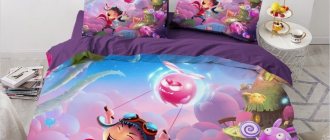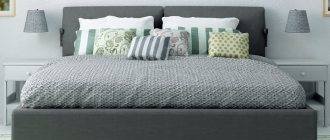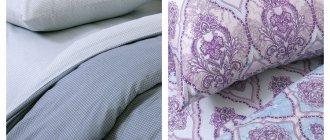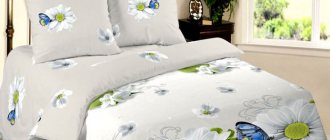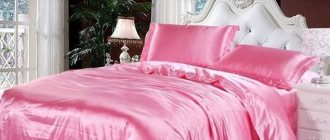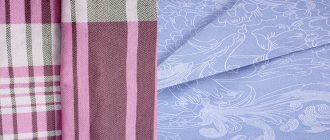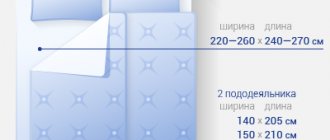Types of bed linen sets
- The one-and-a-half-size set consists of two pillowcases measuring 50 by 50 cm (70 by 70 cm), a sheet measuring 215 by 145 cm and one duvet cover measuring 215 by 145 cm.
- A double set according to the Euro standard includes a large duvet cover measuring 215 by 180 or 175 cm; sheet measuring 220 by 240 cm; a pair of pillowcases, which come in sizes of both 50 by 50 cm and 70 by 70 cm. Sometimes double sets come with a small sheet measuring 195 by 220 cm, and the rest of the set items have the same sizes as Euro.
- European standard for bed linen. This set includes one duvet cover size 200 by 220 cm, two pillowcases 50 by 70 or 70 by 70 cm. The sheet can be of two sizes: 220 by 240 cm or 240 by 280 cm.
- The family set consists of two pillowcases 50 by 70 cm (70 by 70 cm); two duvet covers measuring 215 by 145 cm and one sheet measuring 220 by 240 cm.
- The children's bedding set consists of a duvet cover measuring 115 by 147 cm, a pillowcase measuring 40 by 60 cm and a sheet measuring 120 by 150 cm.
In European countries there is the following classification:
- Triple (king size)
- Double (“2-bed”, full)
- One and a half sets (“1.5-bed”, extra long single)
- Children
- Single (“1-bed”, single).
Attention! For different lingerie manufacturers, the sizes of set items vary from standard by 10–15 cm.
How to choose bed linen
When purchasing bed linen, consumers hope that their expectations will be met: the set will last a long time, the bright colors will not fade, the fabric will not shrink, the duvet cover will fit the size of the blanket, etc. Our useful tips will help you buy high-quality bed linen, and knowledge of a number of technological aspects will allow you to make an informed choice.
Any bed linen must satisfy two requirements: to be comfortable and of high quality. Comfort refers to the ability of a fabric to allow air to pass through and absorb moisture. Natural fibers have these properties: cotton, linen, silk. Products made from durable materials that can withstand numerous washes and painted with durable, safe dyes are considered to be of high quality. The stronger the fabric, the longer the bedding will last. A soft and thin fabric can turn into a pile of torn rags after several washes. The quality of the dyes is no less important, because a set that has faded after the first wash is unlikely to please with its dull appearance. Are you interested in a wide range of high-quality bed linen that will last a long time? Go to the Saylid online store.
Options for choosing bed linen
Material.
The ability of bed linen to allow air to pass through and absorb sweat is essential, so highly hygroscopic natural fabrics such as cotton and linen are most often used to sew it. Natural silk linen serves more as a luxury item than as bedding. Cotton fabrics are represented by materials of various prices: from affordable chintz and calico to more expensive poplin and satin. The presence of synthetic fibers is allowed, which increase the wear resistance of the material, but their quantity should not exceed 30%.
Fabric density.
The greater the density of the fabric, the more washes it can withstand and the longer it will last. Good bed linen should be made from fabrics with a density of at least 40 threads per 1 cm². Sets made from fabrics with soft threads and loose weaving are short-lived and subject to rapid wear.
Color fastness.
High-quality dyes will not only provide your laundry with a lasting color that remains after numerous washes, but will also not harm your health, since the components used in cheap dyes can cause allergies. If the pattern is equally visible on both sides of the fabric, it means that the fabric is woven from dyed threads and will retain its color longer than single-sided prints on the finished material.
Seam quality.
The bed linen is sewn with a special linen seam, which ensures the strength of the connection and eliminates open cuts and protruding threads. Raw edges of the fabric indicate a low-quality product. Really good underwear is made from a single piece of fabric and has no middle seams.
Design.
Modern manufacturers offer a large selection of bed linen options. The duvet cover can have a front opening, a side slit, a wraparound in the middle of the product, or a zipper. Pillowcases can be with a zipper, with buttons or a wrap; sheets with an elastic band are very popular. Well, in terms of colors and patterns, the choice of bed linen is truly limitless.
Packaging and label.
These parameters will allow you to judge the integrity of the manufacturer and the quality of the product. The label must provide comprehensive information about the product: fabric composition, size, manufacturer, tips for caring for the product. The appearance of the packaging and label, the quality of printing, and the attachment to the product speak about the level of prestige of the company.
Types of fabrics for bed linen
Cotton
One of the most versatile and popular materials for sewing bed linen. It is easy for the consumer to choose the desired color thanks to the wide selection. A quality set should be marked: 100% cotton, the fabric should not be see-through. The material is stitched with a special linen seam, the edges and edges are finished with high quality.
Important : The sheet and pillowcase should not have unnecessary seams, as they are sewn from a single piece of fabric. It is not recommended to purchase sets with a strong chemical smell or protruding threads.
Pros: wicks moisture away from the body well; comfortable; pleasant to the body; With proper care, linen is quite wear-resistant and “lives” up to 5–7 years. The fabrics can be washed and ironed well with a regular iron. Cotton does not accumulate static electricity and does not slip on the bed. It is recommended to buy such underwear for children, allergy sufferers, and the elderly.
Cons : Fades under sunlight; When washed frequently, the fabric shrinks and takes a long time to dry.
Silk
One of the most expensive natural fabrics for sewing bed linen, it shines. The material is durable, hypoallergenic and wear-resistant. It has a beautiful appearance and perfectly removes moisture from the body, acting as a temperature regulator in winter and summer.
Pros: the fabric does not stretch, is not a breeding ground for saprophytes, does not electrify, is durable, does not stretch or shrink. When stretched, the fibers of the material do not break. The fabric repels dirt.
Disadvantages: requires careful care (cannot be bleached, washable with special products and only by hand, washing temperature should not exceed 30 degrees). It is not recommended to rub or twist the material when washing. Ironing is carried out only from the wrong side, the material does not need to be sprayed with water, as water stains may remain.
Jacquard
The fabric is made from cotton threads and viscose fibers, possibly made only from cotton. The material has no lint and is created through complex weaving. A pattern with a relief surface is stamped on it in appearance, resembling a tapestry. Jacquard is pleasant to the touch and has a smooth texture.
Pros: strength and density, removes moisture well, thermoregulation. When washed, jacquard dries quickly and does not accumulate static electricity. It is abrasion resistant.
Disadvantage: high cost: if you wash it often, the fabric becomes covered with pills.
Satin jacquard
A material in which twisted cotton thread is mixed to reflect light. It combines smoothness and relief patterns. The surface of satin-jacquard on the front side is smooth with a pronounced shine, and on the back side the fabric is rough. When manufacturing, manufacturers give preference to pastel colors.
Pros: beauty of the material; hypoallergenic; comfortable temperature conditions when used in winter; durability and strength; You don’t have to iron it, it almost doesn’t wrinkle after washing;
Cons: the more synthetics in the fabric, the worse the quality of the material; hot to sleep in summer; slips, especially if the owner of the bedroom prefers to wear pajamas or a silk nightgown.
Type of linen for bed linen
Natural fabric with a unique texture. If you touch the material with your hands, you will feel its rigidity and small knots in the material. Underwear made from it has a massage effect and has thermoregulation. Sleeping under such linen is cool in summer and not cold in winter. In addition, flax has a bactericidal effect. It kills fungus and eliminates inflammation. By absorbing moisture, the fabric does not become wet, dries quickly and does not accumulate static current. It is durable, resistant to light, and does not turn yellow.
Important! The more washes a linen fabric goes through, the softer it becomes.
Cons: wrinkles a lot and is difficult to iron; The canvas is not always pleasant to the body.
Type of calico for bed linen
Fabric made from cotton thread with frequent weaving. If you compare chintz and calico, it will be a little tougher. It is pleasant to sleep on such linen. It is highly hygienic, wrinkles little, is lightweight, and retains the brightness of its colors for a long time even with frequent washing. Linen made from such fabric will be budget-friendly.
Pros: practically does not require ironing, remains bright for a long time, durable, environmentally friendly.
Cons: quite rigid, due to the weaving technology.
Type of chintz for bed linen
The fabric is lightweight, 100% cotton, and can be printed or dyed. The strength of the material is given by the weaving of the weft thread and the warp thread in a ratio of 1 to 1. It has a glossy surface. Excellent not only for bed linen, but also for underwear.
Pros: the fabric is natural and very light. Does not require ironing. It is comfortable to sleep on at any time of the year and absorbs moisture well.
Cons: Due to its low density, it quickly fails, rolls up, becomes deformed and shrinks after washing.
Type of flannel for bed linen
The material is made of cotton threads, lightly brushed, tightly woven. Manufacturers sometimes add synthetics during production, but this does not affect the quality of the material. The pile can be on one or both sides of the fabric. Density is determined not by thread frequency, but by weight.
Pros: does not require careful care; becomes softer with each wash; pleasant to the body; Perfectly warms you up while you sleep in winter. The material is soft and has a pleasant fleecy feel.
Cons: takes a long time to dry, rolls up quickly, wrinkles a lot.
Type of polycotton for bed linen
Fabric based on cotton and polyester. But the material is not synthetic, therefore the polyester content does not exceed 35%. Almost does not fade, pleasant to the touch, washes well.
Pros: The material is strong and durable, soft, doesn’t get dirty easily, washes well. The material hardly wrinkles and does not shrink after washing. You don't have to iron it.
Cons: If there is little cotton thread in the linen, then the environmental friendliness of the material decreases. The fabric becomes electrified and requires antistatic treatment. Do not bleach with chlorine. The rougher the tissue, the faster pili form.
Type of poplin for bed linen
The material for such bed linen is made from cotton, silk, viscose or fiber threads. Synthetics. The fabric is durable, but pleasant to the touch, thanks to the manufacturing technology. The threads in it are arranged so that the outside is softer and thinner, and the inside is coarse and thick. The shine is similar to satin. It can be printed, plain-dyed, etc. It is often 100% cotton. Almost does not wrinkle, is light and allows air to pass through well.
Pros: Has high wear resistance, softness; has a beautiful shine; does not require special care procedures. Does not lose brightness for a long time, does not deform. You don't have to iron it.
Minus: if there are wool threads in the fabric, it shrinks when washed. If it is necessary to hem the fabric, it is difficult to process.
Type of cambric for bed linen
The material is based on linen or cotton, has a 100% natural composition, smooth surface. It is durable, wicks moisture well, is slightly transparent and very light. This fabric is used for luxury bedding.
Pros: pleasant to the touch, thin and light. The fabric is highly durable, hypoallergenic, and holds its shape well. It washes and irons well.
Cons: Requires special care; washing such a set should be delicate.
Type of viscose for bed linen
Artificial fabric for bedding, made from cellulose-based fiber. But its properties are similar to natural fabrics, it has a pleasant shine, does not lose its brightness for a long time, and is pleasant to the touch.
Pros: Hypoallergenic, durable material, absorbs well, practically does not shed, does not electrify. Can be folded into beautiful folds and draped. It is not hot to sleep under it in summer, and not cold in winter.
Cons: wrinkles a lot, is exposed to sunlight, may shrink when washed.
Type of microfiber (microfiber) for bed linen
The material is made entirely of polyester, its properties are similar to cotton. The material is durable and perfectly absorbs moisture. Scientists believe that such materials are the future of the textile industry.
Pros: the material is soft, pleasant to the touch, almost does not roll down. It is easy to care for, the fabric does not wrinkle and is easy to wash, it is abrasion resistant and does not fade. Not exposed to sunlight. After washing, it dries quickly and is not “afraid” of moths, fungus and dirt.
Cons: Cannot be washed and dried at high temperatures. Despite the fact that the fabric absorbs perfectly, it retains fat. Susceptible to the accumulation of static electricity.
Type of bamboo for bed linen
The material, based on a thread made from bamboo pulp, is environmentally friendly and hypoallergenic. Feels like cashmere or silk. It is softer than cotton, has a shiny surface and an antibacterial effect. Most often the color of the fabric is light green.
More detailed article about bamboo bedding.
Pros: environmentally friendly, pleasant to the body material, does not irritate the skin and does not cause allergies, destroys germs. This fabric serves as a thermostat and absorbs moisture well.
Cons: high cost.
Which bedding from expensive fabric to choose
The most optimal is a set made of natural satin without impurities. Textiles differ from silk in their strength and density. Expensive fabric has thermoregulation and a pleasant appearance. Does not shrink during the first wash and does not wear out quickly with frequent use. Thanks to its matte finish, it does not wrinkle, does not slip, and does not cause discomfort.
A bamboo bedding set is an option for people with a tendency to allergies and skin irritations. Does not roll down, does not slip, made from antibacterial raw materials. Due to its elasticity, air circulates well and does not absorb sweat.
Popular silk is a very expensive fabric, especially the Japanese version, made by hand. Such fabric should be washed only on a gentle wash cycle, avoiding sudden temperature changes and the appearance of stains. Also, the kit is only suitable for summer, as it does not have heat resistance and good temperature regulation.
Important! Silk is one of the most pleasing fabrics, despite its high cost and luxury.
Density of fabric for bed linen
This characteristic depends on the weaving method when making the material, and the digital content reflects how many threads are contained in 1 cm2. The denser the fabric, the longer it will last. The lowest density is for a cambric set; cotton and linen are considered medium density. The satin set has the largest number of threads per 1 cm2.
Based on density, materials are divided into the following groups:
- Low count: 20 to 30 threads
- Below average thread count: 35 to 40 thread count
- Medium density: 50 to 65 thread weave
- Above average thread count: 65 to 80 thread count
- High density: thread count varies from 85 to 120
- Very high: threads per 1 cm2 from 130 to 280.
Materials - we analyze compositions and densities
The next important component of well-chosen bed linen is the quality raw materials from which it is made. The undisputed leaders in this parameter are natural materials:
- cotton;
- linen.
- silk;
Such fabrics are pleasant to the body and durable.
Cotton
Few fabrics can compete with it in popularity. Cotton is almost ideal for sewing both clothes and bedding. Its main advantages:
- relatively low cost, which depends on the type of raw material processing;
- hypoallergenic;
- high strength and wear resistance;
- ease of care;
- high hygroscopicity and breathability;
- comfort (allows you to sleep comfortably, regardless of whether the room is hot or cool).
Linen
Linen is another good option for bedding. The material is high-quality, natural, wear-resistant, durable and can withstand a large number of washes, about 200. Linen is recommended for people suffering from skin diseases. At first, this fabric often seems rough and stiff, but over time it always softens. Also, pure linen wrinkles a lot and doesn’t iron well, so it’s worth taking a closer look at linen that contains cotton.
Silk
Silk is an exquisite material that evokes romance and speaks of the luxury and wealth of the owner. When touched, it is a cool, pleasant and gliding fabric. High-quality natural silk has the following characteristics:
- high strength;
- good breathability;
- ability to repel dust;
- antiseptic: silk does not breed parasites;
- resistance to snags;
- dielectricity: the fabric does not electrify itself and does not electrify the hair, which will be appreciated by girls with thin and curly hair.
Advice! The best and highest quality silk is Japanese.
The disadvantages of this material can be considered:
- high cost;
- sliding properties;
- Requires careful handling and hand washing or dry cleaning.
A silk sheet will not fly off the mattress if it is secured with an elastic band and not just tucked under or hanging down.
Weaving threads
When you come across such names as calico, twill, jacquard, percale, satin, chintz, cambric, etc. on packaging, it is worth remembering that all these are fabrics with one or another processing of natural materials, with the addition of certain synthetic impurities and with different weaves. They all differ in their properties and feel differently.
The most popular cotton fabrics:
- Calico, depending on the density and the presence of knots on the fibers, is in the middle or low price category. According to Russian standards, it consists entirely of cotton. Imported calico may contain a small amount of synthetics. Good calico is not cheap, it is dense, does not wear out and does not fade over the years, does not deform and does not fade. It is uncomfortable for people with high tactile sensitivity.
- Poplin is distinguished by a transverse rib, which is formed thanks to a special weaving technique. The material has a delicate shine and very high density, thanks to which poplin makes good bedsteads.
- Satin resembles delicate silk in appearance and properties, but consists entirely of cotton. It has good density and durability, delicate smoothness, but it is a less cool and slippery fabric than silk. Satin costs more than calico.
- Percale is a thin and delicate material, very smooth and silky when touched. It has a high density and can withstand a large number of washes.
- Chintz is a budget practical fabric. It does not require special care. However, it does not tolerate washing well and thins out quite quickly.
- Batiste is a delicate, flowing and very pleasant material to the body. It has a fairly high cost. Linen made from this fabric is more suitable for special occasions than for everyday use, because... wears out very quickly.
Density
Density determines how well the fabric allows air to pass through, absorbs dust and absorbs or repels moisture. To a lesser extent, the indicator affects resistance to deformation and wear.
Note: Calico made from long, well-twisted and purely natural fibers will last longer than dense calico made from short, knotted fibers and loosely twisted threads.
The easiest way to estimate density is by touch, but if the kit is sealed, you need to read the data on the packaging. The measurement is usually the number of threads per square centimeter or the number of grams per square meter.
For example, a density of 20-30 threads per 1 square meter is considered low. centimeter, and starts with indicators of 60-80 threads per 1 square. centimeter.
Advice! When choosing a set or fabric for sewing, evaluate naturalness and density: the more, the better. A good option - and with a small admixture of synthetics, it makes the material cooler and more wear-resistant.
Colors
The modern market offers bed linen in many color variations. Plain and colorful, with prints and inscriptions, bed colors and bright shades. A special category is lingerie with photo printing, the so-called 3D lingerie. When choosing colors, you need to focus on your taste, bedroom design and operating conditions. Thus, linen for newborns will have to be washed frequently, so either the dyes must be very durable, or pastel colors must predominate.
Color fastness
The stability of the pigment depends on the type of dye and the method of application by the manufacturer. It is difficult to recognize the durability of the paint used by eye, but do not despair.
The pigment for coloring is divided on a 5-point scale, the optimal indicator for pillowcases, sheets and duvet covers: 4.
Important! Check the label for the optimal washing temperature. The higher the temperature, the more stable the coloring.
Rub the material of the linen well with your palm; if the paint is resistant, then there should be no marks left on your hand.
Design
Everyone chooses bed linen to their own taste, but there are a number of tips that will help you make your choice:
- The color scheme of the set should be combined with the style of the room. If it is impossible to choose a shade for the interior, it is better to choose light and pastel colors.
- Romantic types are advised to opt for lingerie with flower prints, lace, bouquets, and retro photographs.
- For people with a strong will and a penchant for shocking, original solutions are recommended: printed unusual prints, oriental style.
- Sets with vegetation and nature are perfect for a balanced and calm person.
- For a business person who spends the whole day in the hustle and bustle, plain sets are recommended.
- If the bedroom has a bed made of natural wood, then the beauty of the wood will be emphasized by blue and white colors.
Options for choosing bed linen
Before purchasing a new bedding set, you should decide on its purpose. That is, purchase a classic set for traditional use, to add beauty, or give it as a gift. In each case, you will find what you need in a certain style, at the required properties and at the required cost.
Additionally, you should determine the necessary material properties that the purchased set must have. Namely, its degree of density, brightness of shades.
Packaging and label
Remember : That a self-respecting manufacturer who does not skimp on the quality of the product and its proper transportation will not skimp on good packaging.
The name of the company producing the product, contact information, and address are written on the label; fabric composition and its percentage, if several types of threads are present. All sizes of the set items and their list must be written down, and there are recommendations for washing and care.
Reputable manufacturers
Based on the rating based on customer reviews, it will include the following companies:
- “Blakit” (Belarus, Baranovichi). Affordable price, good quality, linen does not lose its appearance for a long time and does not fade. Main prints: geometry, abstraction, rich shades, neutral designs.
- "Monolith". Manufacturer: Russia. It produces sets from economy class to elite, has 31 branches in Russia and the CIS countries. Features: brightness of tones, natural fabrics, budget cost, dense materials with increased wear resistance, gift packaging.
- "ArtBed". Manufacturer: Russia, Ivanovo. Features: many prints, low price, high-quality packaging and tailoring.
The main criteria for choosing underwear
An experienced housewife knows how to choose bed linen and is guided by her preferences. Young ladies need to familiarize themselves with the rules that allow them to navigate the huge assortment and find the best options. When choosing bedding, you need to consider the following criteria:
- purpose;
- specifics of operation;
- personal preferences;
- interior features.
Most bedding is purchased for everyday use. For these products, important criteria are strength, durability, and ease of maintenance. These requirements are fully met by calico and poplin sets.
For everyday use, durability is an important criterion
If you need to buy products for romantic meetings, you should pay attention to the photo of beautiful bed linen made of silk or satin. As a gift, cambric, linen, and jacquard products from the elite category are presented.
Silk bed linen for special occasions
Bed linen design
When choosing underwear, you need to pay attention to the aesthetic characteristics of the products. Bedding can influence psychology and evoke certain emotions. By looking at photos of bed linen, you can determine whether the design matches your personal ideas about comfort.
All fabrics used in the production of products are perfectly dyed. The range covers a rich palette of shades. Modern technologies make it possible to apply drawings in various subjects and create spectacular images in 3D format. In order for bed linen to provide a positive emotional impact and become an interior decoration, when choosing you need to consider:
- the mood that needs to be created before relaxing;
- personal preferences in shades, themes;
- bedroom design features.
Spectacular bed linen with 3D images
Bedding for everyday use should soothe, create a feeling of comfort, warmth, and a desire to relax. This is facilitated by pastel shades, natural, floral themes, ethnic ornaments, and geometric patterns. In underwear intended for romantic dates, colors with high energy are used, animalistic themes and appropriate symbolism are acceptable.
Pastel shades create a feeling of comfort
Linen is part of the textile decor of the bedroom. When choosing products, you need to take into account the interior style and finishing shades to ensure harmony.

